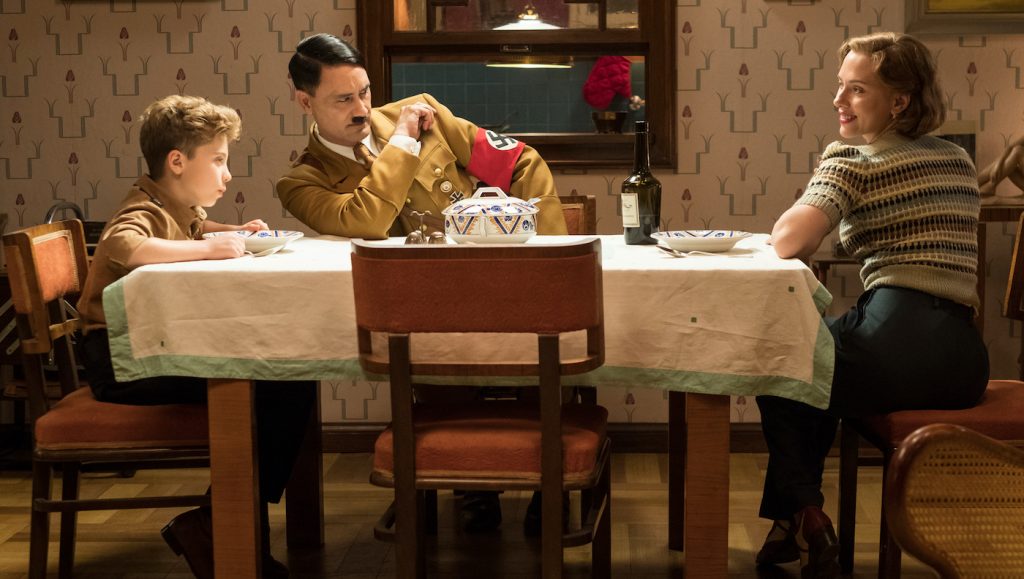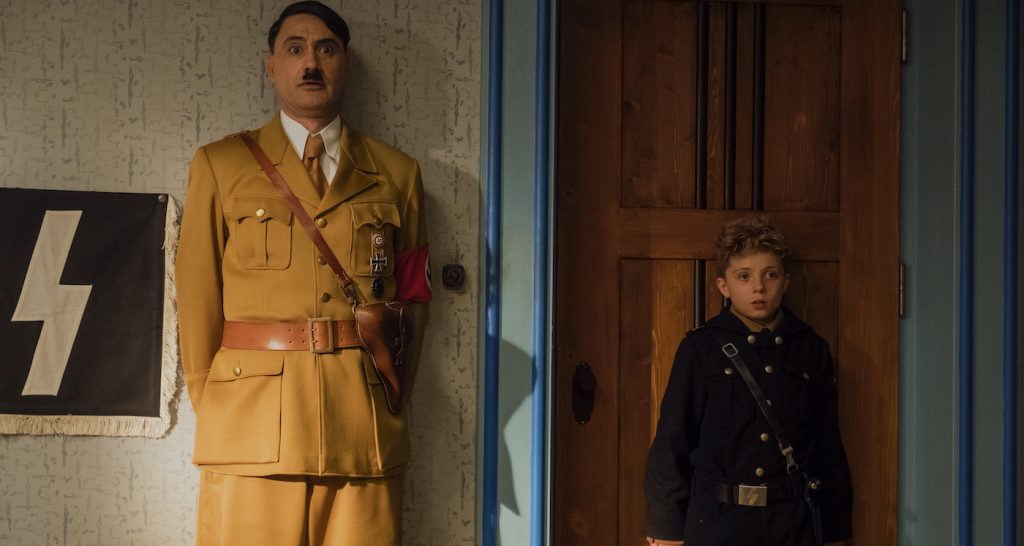How Jojo Rabbit’s VFX Supervisor Helped Taika Waititi Create the Year’s Wildest Comedy
The most startling visuals in Jojo Rabbit (which opened last Friday) takes the shape of writer-director Taika Waititi dressed up as Adolph Hitler, the imaginary best friend conjured by a German boy (Roman Griffin Davis) during the waning days of World War II. But while “Hitler” commands the foreground, VFX supervisor Jason Chen worked a more subtle brand of filmmaking magic by using digital tools to seamlessly build out Jojo’s world. Chen says, “The shots were filmed on actual ruins in the Czech Republic left over from World War II, but then we would place blue screens on the edge of the sets and extend them out.”
Chen teamed with production designer Ra Vincent and cinematographer Mihai Malaimare Jr. to reinforce the eye-popping color scheme that distinguishes Jojo Rabbit from most World War II movies. “Usually World War II films are a little dark and de-saturated, whereas Jojo Rabbit is very vibrant,” Chen says. “That’s because a lot of people toward the end of the war dressed to the nines, thinking they were going to die by the end of the day. They were literally living their lives as if tomorrow would never come, so that’s why we used this very bright palette. Our set extensions have little subtleties like neon wallpaper and pink buildings and purple buildings that play into the childlike sensibility of Jojo’s mind. At the same time, it’s a metaphor for him being thrust into this reality of this world as it crashes down around him.”
To transmute real-life brick and mortar into pliable pixels, Chen arranged for Clear Angle Studios to set up 3D scanners on tripods in the little village of Zatec, where most of the action takes place. Chen says “The scanner device shoots out a laser beam and rotates around capturing 3-D data which is reflected back from the surface of the environment. We do a complete 360 scan of the architecture and bring it into the computer for a pretty accurate representation of the buildings that surrounded the set. We scanned two to three miles of Czech streets that had historic relevance to our story, including the town square where Jojo lives. That was actually occupied by Nazis and Hitler held a lot of rallies there.”

Chen pulled out all the stops for the film’s third act battle sequence. “We shot a lot of elements against blue screen that were repurposed later in post-production,” he says. “Explosions, tanks, people running, pretending to die, smoke, gunfire, all the kinds of things we’d typically film against blue screen for a big movie.”

Chen and his team shot most of the background “plates” during principal photography in the summer of 2018, but for one key sequence, filmmakers returned to the Czech Republic in January. “Audiences wouldn’t realize this but the scene where Jojo sees a butterfly was actually shot during the summer,” Chen says. “When we went back for re-shoots early this year, we photographed a ton of snow on the streets and laid those [background] plates into the computer. We basically winterized the entire sequence.”
To complete the scenario, Chen and animation artists at Luma Pictures obsessed over the butterfly itself. “We had to do a lot of iterations to arrive at the personality of the butterfly,” he recalls. “We wanted to make it a little bit whimsical but at the same time, we had to make sure it looked completely real. It’s always a fine line on a movie like this. We’ll go to the extreme creatively, but then we always bring it back to make sure we stick within reality because we want to represent this [time period] with great respect.”
Jojo Rabbit marks a relatively low-budget change of pace for Chen, who’s worked on several tentpole blockbusters over the course of a ten-year career inspired by Jurassic Park. “I was completely fascinated by that film when it came out,” recalls Chen, who grew up near San Francisco. “My parents got me a behind-the-scenes book and I went through it every night. That’s when I really got into visual effects.” During high school, Chen spent summers in L.A. studying at the New York Academy. A classmate invited him to hang out with Steven Spielberg and Peter Jackson when they did camera tests for The Adventures of Tin Tin. That led to a go-fer gig on James Cameron’s groundbreaking Avatar. Chen says, “I started out by memorizing coffee orders and went from there to figuring out facial capture, motion capture, compositing, and 3-D. I was lucky to get my bearings on that project.”
Chen first worked with Waititi on the director’s irreverent Marvel movie Thor: Ragnarok and also VFX-supervised his vampires-in-Brooklyn comedy series “What We Do in the Shadows.” Chen says, “Working with Taika is like a party. He’s really smart about every single aspect of every single department and embraces the idea that it takes a lot of people to make a movie. Nobody’s above anyone else. Anybody can speak if they have an opinion. And that’s very refreshing.”
Featured image: Taika Waititi and Roman Griffin Davis in the film JOJO RABBIT. Photo by Kimberley French. © 2019 Twentieth Century Fox Film Corporation All Rights Reserved
For more of our coverage on Jojo Rabbit, check out our interview with production designer Ra Vincent, and our review from the film’s world premiere at the Toronto International Film Festival.



